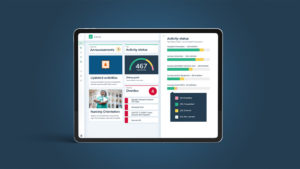By Glenn Ruud, Global Head of Learning & Development in DNV GL. A closer look at the critical role of the line manager as competence manager and how to ensure management buy-in for successful implementation.
The 70:20:10 approach to learning and personal development is becoming increasingly popular in both the public and private sectors. Although not a fixed formula (despite what many seem to think) it provides HR and learning and development (L&D) professionals with a shared overall understanding of where learning takes place and how we can systematically facilitate and support its ongoing realization.
At DNV GL Oil & Gas, the HR department’s competence and learning function has been working in accordance with the 70:20:10 learning philosophy for more than four years now. We have learnt through trial and error, and have explored various approaches in close collaboration with senior management and regional management teams. Through this real life “learning laboratory” in partnership with senior managers, we have arrived at a shared understanding of what it means to implement 70:20:10.
Managers drive performance and results
In the early stages of introducing 70:20:10 to the organization we realized that managers are critical for successful implementation. In many ways this goes without saying, as they are the ones responsible for driving performance and delivering results through their employees. And that is something which happens on the job, in real life projects with customers.
An interlinked dimension, which in my experience is all too often overlooked, is the role of line managers as competence managers. A quick internet search gives you plenty of articles explaining the manager’s role in many HR domains, such as staff recruitment, talent development and retention, as well as employee learning and development. Yes, HR and L&D professionals play a vital part in facilitating the development of people in an organization, but line managers are the ones who really determine the extent to which their subordinates grow as productive contributors to the bottom line.
In an article published by Harvard Business Review[1], Monica Valcour takes it one step further and claims that “if you as a manager are not helping people develop then you are really not management material”. This makes perfect sense if you believe that most learning and development happens on the job, through new challenges and development opportunities in real life projects, rather than mainly through formal training.
Becoming a good competence manager takes training and practice, just like any other leadership skill. And helping managers become good competence managers is, in our experience, one of the most important success factors in implementing 70:20:10. Developing good competence managers, who set a clear direction for their employees and create high-quality development plans, ensures that the organization as a whole will be able to constantly build and maintain the competence it needs. For meeting the organization’s competence needs should always be the primary focus of your 70:20:10 implementation efforts. However, before you embark on any such journey, you must first make sure that senior management is fully on board and prepared to give 70:20:10 implementation with the resources and backing it requires.
The process of implementation
So what does that mean and how can you as an HR business partner or L&D professional ensure senior management buy-in for a 70:20:10 implementation journey?
Work on a mind shift in your self
In my experience, the first thing you have to do is to work on a mind shift in yourself. Your biggest opponent will probably be yourself, because implementing 70:20:10 takes you out of the comfort zone of developing learning solutions and into the unknown territory of experiential learning. Here you will need to work closely with line managers and not for them in the effort to convert increased competence into market outcomes. If you have been spending most of your time on formal training (the 10 part), now is the time to focus on the experiential (70) part of the learning ratio, so you can help managers become better at managing their people’s competence.
In practical terms it means you must have a good value proposition to put to senior management. You must explain exactly why they should embark on such a journey, i.e. what’s in it for them and how this competence initiative can ensure enhanced business value and the realization of business goals, and is not just another series of courses or workshops?
Align the most important business challenges
Secondly, your 70:20:10 value proposition must be aligned with the most important business challenges. This means that you must understand the organization’s strategy, business opportunities and challenges, and how you can help managers achieve better results through 70:20:10 implementation. In our experience, you must, as Valour states, “systematically link organizational performance and individual development goals”, i.e. ensure business-driven learning that is aligned with the most important strategic business challenges. The way we do this at DNV GL is to help managers create relevant competence development plans for their section or department, which are then systematically cascaded down to each employee and their individual development plans.
Focus on actual business outcomes
Thirdly, search for influential champions, preferably line managers who can provide support and are willing to act as pioneers for the scheme. Spend time with them, understand their business, market and staffing challenges, and package the 70:20:10 competence-building concept around that. By doing so, and by approaching 70:20:10 implementation with a focus on actual business outcomes, you will have a greater chance of winning the support of other line managers.
Remember to measure and celebrate the process
When you have the organization’s backing and trust, you should pilot the concept in a single department, region or country. Agree measurable outcome targets, facilitate processes with the managers, train them on selected topics and follow up regularly in order to help them achieve those targets. Finally, it is important to continuously measure and celebrate progress, showcase results and communicate them to the organization as a whole in order to give recognition to the managers involved.
At DNV GL it was agreed that we should help managers increase the quality of employees’ individual development plans. High-quality individual development plans, focusing not only on formal training but specific and measurable targets in the 20 and 70 parts, were perceived to be of high value. Why? Because having better quality development plans increases the likelihood of that plan being realized, as well as securing the commitment of both manager and employee to its accomplishment. In addition, we spent time analyzing people’s development plans and measured the progression in quality throughout the year. By doing so, we could provide the managers with tangible evidence of progress towards an agreed, measurable target, and help them showcase that the investment in training and support was worth it.
This is an ongoing journey, which requires regular follow up and management buy-in in order to avoid fatigue and the gradual abandonment of the 70:20:10 learning philosophy. In our experience, if you continuously secure value through the realization of agreed targets and regularly showcase the progress being made towards those targets, the likelihood of fatigue and the risk of discontinuation will decrease.
A critical success factor
The Oil & Gas division’s current processes and practices with regard to 70:20:10 implementation include a 5-step approach. A critical success factor is to secure senior management buy-in to the processes involved. That commitment will only be given if we can show that we understand their ever-changing business challenges and persuade them that we can help them meet their commercial objectives through business-relevant competence building.
At the end of the day, it doesn’t really matter what people know, unless they are able to systematically use what they know to create value for the organization. That is the mindset you must have when attempting to gain the commitment of your organization’s senior management. The real proof of success will not be the delivery of high-quality competence enhancement initiatives, but the improvement in market performance that is the tangible outcome of increased employee competence.
[1] Valcour, Monique «If you are not helping people develop, you are not management material” Harvard Business Review, January 23, 2014
Glenn Ruud is Global Head of Competence and Learning at DNV GL, Oil & Gas. He has spent most of his career in executive education and competence development, first with educational projects in NGOs and the United Nations, followed by more than a decade in business education and leadership development, before he joined DNV GL. His main interests are 70:20:10 implementations for enhanced business impact and increased staff satisfaction, better alignment of competence initiatives with business goals and maximum return on investment in training and development.




